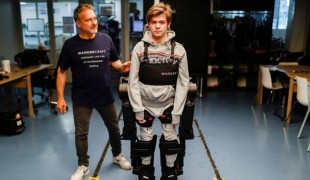- 7778
- 507
- 19
- 20
- 0
- Help Ukraine
About the solution
All of these situations led Conor to become a brain enthusiast, so he started hacking EEG by referring to some online and open-source tutorials.
Joel Murphy, the other OpenBCI co-founder, had created the Pulse Sensor, an optical heart rate monitor (with Yury Gitman). Conor met him because he had been hired as a subcontractor and helped in firmware development of this project. The Pulse Sensor got a lot of interest from the public, which led to a successful Kickstarter campaign (in 2011).
This helped build the path for the development of many other open-source, adaptable, and affordable human-computer interface technologies (mind-controlled devices).
So the team founded OpenBCI, a company that produces open-source innovation of brain-computer interface technologies, after another successful Kickstarter campaign, in 2013.
“Our Arduino compatible biosensing boards provide high-resolution imaging and recording of EMG, ECG, and EEG signals. Our BCI devices have been used by researchers, makers, and hobbyists in over 60+ countries as brain-computer interfaces to power machines and map brain activity. OpenBCI headsets, boards, sensors and electrodes allow anyone interested in biosensing, neurofeedback, and brain-computer interfacing to purchase high-quality equipment at affordable prices”, says on the official website.
Tempt One, a locked-in graffiti artist, has used the OpenBCI and the low-cost Eyewriter eye-tracking system to continue to draw after being diagnosed with ALS.
Adapted from: https://bit.ly/2OgqiRa
https://bit.ly/2ua2eC0
https://en.wikipedia.org/wiki/OpenBCI
More info: http://www.openbiomedical.org
https://www.youtube.com/watch?v=QIWswAOFp8w
This solution shall not include mention to the use of drugs, chemicals or biologicals (including food); invasive devices; offensive, commercial or inherently dangerous content. This solution was not medically validated. Proceed with caution! If you have any doubts, please consult with a health professional.
DISCLAIMER: This story was written by someone who is not the author of the solution, therefore please be advised that, although it was written with the utmost respect for the innovation and the innovator, there can be some incorrect statements. If you find any errors please contact the patient Innovation team via info@patient-innovation.com
-
-
613
-
0
-
8956

Man who had a concussion creates computer interface to get brain data
COMMUNICATION: Communicating, whether by speaking, listening, or other means
CAREGIVING
Rubgy
Brain Injury (Abscess, Brain Barrier Defect, Brain Contusion, Brain Hemorrhage, Brain Edema)
Cervical spinal cord injury/Tetraplegia
Assistive Technology access
App (Including when connected with wearable)
Difficulty coordinating movements
Muscle weakness
Memory loss
Sleep disturbances
Headaches
Dizziness or lightheadedness
Managing Neurological Disorders
Preventing (Vaccination, Protection, Falls, Research/Mapping)
Neurology
Sports Medicine
United States
-
-
-
404
-
1
-
4353

Mother invents drone to help track her autistic child
CAREGIVING
COMMUNICATION: Communicating, whether by speaking, listening, or other means
Autism
Alzheimer's Disease
Assistive Daily Life Device (to help ADL)
Assistive Technology access
Anxiety
Difficulty concentrating or making decisions
Difficulty coordinating movements
Muscle weakness
Loss of balance
Social withdrawal or isolation
Difficulty speaking or understanding speech
Memory loss
Irritability or anger outbursts
Confusion
Restlessness or feeling slowed down
Sleep disturbances
Loss of interest or pleasure in activities (anhedonia)
Mood swings
Sensitivity to light or sound
Fatigue
Managing Neurological Disorders
Preventing (Vaccination, Protection, Falls, Research/Mapping)
Caregiving Support
Child and Adolescent Psychiatry
General and Family Medicine
Neurology
Pediatrics
Psychiatry
United States
-
-
-
401
-
0
-
5613

Father creates exoskeleton to help son with genetic neurological condition walk
BODY BALANCE: Maintaining body balance
STANDING UP: Standing up from a seated position
WALKING WITH A WALKING AID: Walking with a walking aid
CAREGIVING
Cervical spinal cord injury/Tetraplegia
Assistive Technology access
Walking Aid (wheelchair/walker/crutches)
Restoring mobility
Managing pain
Promoting self-management
Preserving Organ Function
Managing Neurological Disorders
Recovering from Traumatic Injuries
Maintaining Balance and Mobility
Restoring Blood Circulation
To improve Treatment/Therapy
Preventing (Vaccination, Protection, Falls, Research/Mapping)
Raise awareness
Caregiving Support
General and Family Medicine
Intensive Care Medicine
Neurology
Physical Medicine and Rehabilitation
Sports Medicine
France
-
 en
en